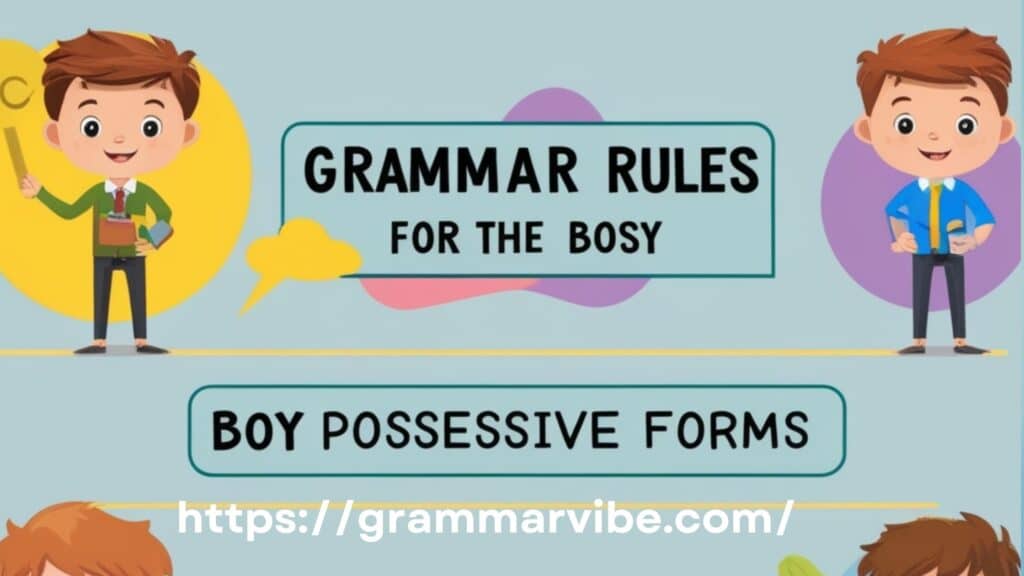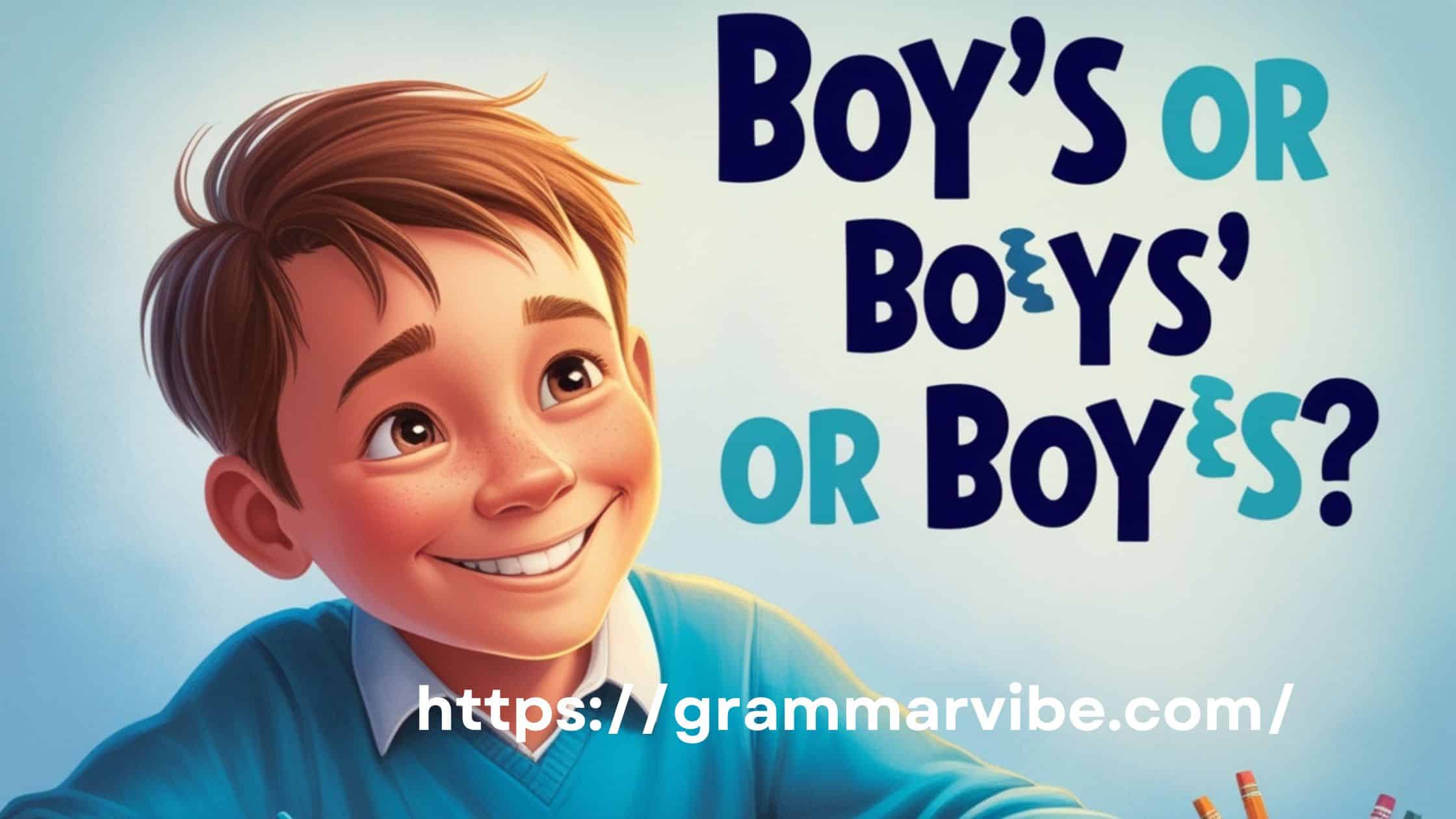Understanding possessives can be a challenge, especially with nouns like boy, which can take multiple forms depending on singular or plural usage. Should it be boy’s, boys’, or simply boys?
In this article, we’ll explore the correct usage of each form, explaining singular possessive and plural possessive rules with plenty of examples. By the end, you’ll have a clear understanding of the possessive form of boy, and you’ll know exactly when to use boy’s, boys’, or boys.
1. Singular Form: Boy
When you’re talking about just one boy and don’t need to show possession, you’ll use the standard singular form, boy. This form is non-possessive, simply referring to one individual without indicating that they own anything.
Example Sentences:
- The boy ran across the playground.
- A boy joined the chess club last week.
In these sentences, boy is used in a non-possessive form to describe one child.
2. Plural Form: Boys
The standard plural of boy is boys. This form indicates that you’re talking about more than one boy without showing possession or ownership.
Example Sentences:
- Three boys sat together at lunch.
- The boys practiced for the school play after class.
Here, boys refers to multiple children. Note that there’s no apostrophe because no ownership is being indicated.
3. Singular Possessive: Boy’s
The singular possessive form of boy is boy’s, used when one boy possesses something. To form the singular possessive, add an apostrophe followed by an “s” (boy’s). This form highlights that something belongs to one specific boy.
Example Sentences:
- The boy’s bike is new. (boy’s = belonging to one boy)
- She admired the boy’s drawing in art class.
In each case, boy’s indicates that a particular item (a bike or drawing) belongs to one boy. The boy’s bike shows ownership by a single individual.
Check out this: Denis’ or Denis’s
4. Plural Possessive: Boys’
When referring to something owned by more than one boy, you use the plural possessive form, boys’. In this case, add only an apostrophe after boys (boys’) to indicate possession by multiple boys.
Example Sentences:
- The boys’ soccer team won the championship.
- Someone took the boys’ jackets from the coat rack.
In these examples, boys’ shows that multiple boys own or are associated with these items (the soccer team and the jackets).
Grammar Rules for Boy Possessive Forms

To ensure accuracy when writing possessive nouns like boy’s and boys’, here’s a quick guide to grammar rules and apostrophe placement:
- Singular Possessive: Add an apostrophe and an “s” after boy to show that something belongs to one boy (boy’s).
- Plural Possessive: For multiple boys, add an apostrophe after boys to form boys’.
- Non-possessive Plurals: Just add “s” to make boy plural, without any apostrophe (boys).
Using these rules makes possessives more straightforward, letting you easily differentiate between boy’s, boys’, and boys based on context.
For your interest: Other Ways to Say “Thank You for Reaching Out to Me”
In-Depth Examples by Context

Let’s look at how each form of boy can appear in different contexts. This will help you see the possessive structure and choose the correct form in various scenarios.
Boy’s in Physical Ownership
When one boy possesses a physical object, like a toy or book, you use boy’s.
- Example: The boy’s toy was left on the playground.
- Here, boy’s shows that one boy owns the toy.
Boys’ in Group Ownership
When a group of boys collectively owns or is associated with something, use boys’.
- Example: The boys’ locker room is located near the gym.
- Boys’ shows that the locker room is designated for multiple boys.
General Non-Possessive Plural Use
For instances where you’re referring to more than one boy without possession, use boys without an apostrophe.
- Example: The boys are playing at the park.
More for you: Other Ways to Say “Positive Impact”
Possessives and Specific Scenarios
1. School Settings
When talking about areas or items designated for boys in school, such as uniforms or clubs, you’ll often see the plural possessive form, boys’.
- Example: Our school has a boys’ basketball team.
- Here, boys’ shows that the team is for multiple boys.
2. Family Gatherings or Social Events
Possessive forms of boy are also used for events or trips involving multiple boys.
- Example: They’re planning a boys’ trip to the lake this summer.
- Boys’ trip implies the trip is planned for multiple boys.
3. Singular Possessive in Daily Life
In daily life, the singular possessive, boy’s, is common when referring to personal items or characteristics that belong to one boy.
- Example: She noticed the boy’s excitement for the game.
- Boy’s excitement emphasizes that one boy feels this way.
4. Boys’ in Sports Teams or Group Activities
The plural possessive, boys’, is frequently used to show team activities or events associated with boys.
- Example: The boys’ soccer team practices every evening.
- Boys’ soccer team signifies that the team includes multiple boys.
5. Boys in General Usage
In non-possessive sentences where you’re simply talking about multiple boys, use boys without any apostrophe.
- Example: The boys were thrilled about the camping trip.
You might also like: Other Ways to Say “Thank You for Confirming”
Summary of Boy Possessive Forms
| Form | Possessive Structure | Example Usage |
|---|---|---|
| Singular | boy | The boy is studying. |
| Plural | boys | The boys went hiking. |
| Singular Possessive | boy’s | The boy’s hat was blue. |
| Plural Possessive | boys’ | The boys’ jackets were on the rack. |
Mastering Possessives in Everyday Grammar
Possessives are more than just rules; they add clarity to your writing. Whether you’re describing a boy’s bike or discussing the boys’ school, knowing when and where to place the apostrophe makes all the difference. By following these grammar rules, you’ll be able to communicate clearly and confidently, using possessives that make sense in every context.

Kyren Paul is an experienced blogger and the creative mind behind “Grammar Vibe.” With a passion for the nuances of English grammar, he brings clarity and insight to everyday language topics, making grammar accessible and engaging for readers of all levels.











Leave a Comment